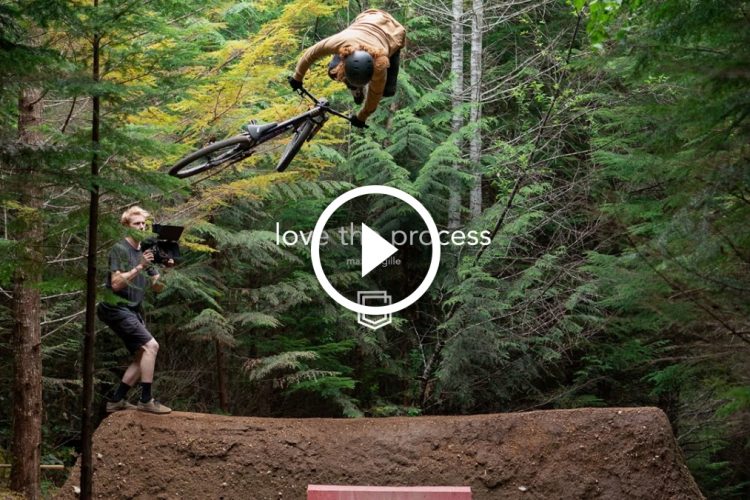
Jumping and pumping smooth rollers is a gas on any bike, and it gets even better on a purpose-built machine with all of the right angles and components. Most of DJ bikes use 26″ wheels, 100mm DJ-specific forks, and a lot of brands only make one size. So how does one select the right dirt jump bike for their desired riding style and terrain? What makes one bike better than the other? We asked a few industry professionals about the dirt jump bikes they design and ride, and we hope their insight will help you find the party ride you’ve been searching for.
Our main dirt jumper info source is Dylan Bibbins, who works at Evil Bikes in Bellingham, Washington. Dylan learned to ride dirt jumps on a mountain bike back in the day, and he says that, at first, the BMX kids who built the tracks were not stoked to share their creations with mountain bikers. He rallied a crew to build some jump lines for mountain bikes, which quickly earned the respect of those skeptical BMX cats, and many of them have since become close friends despite their glaring wheel-size divide.

Dirt Jump Bike Components
The first piece of advice that Dylan shared for newcoming dirt jumpers is to buy a complete bike. Components for DJ bikes are often a mix of BMX and MTB spec, and some of them can be hard to find, making complete builds the simpler option. For example, the Evil Faction 2 uses a BMX crankset and BB so finding the correct size parts can be tricky if you only know the spec for MTB components. In order to maintain a small chainring and overall tight drivetrain, the bike also uses a BMX rear hub that allows for a 9T cog mounted directly to the freehub assembly. There are not a lot of companies out there making 26″ wheels with these hubs, so buying a bike that already has them will save some hassle.
Keeping the chainring diameter as small as possible allows frame designers more wiggle room to make the bike’s chainstays as short as possible for max maneuverability, while also allowing the rider to try more tricks without worrying about banging a larger chainring into things. The tiny 9T cog out back paired with a small chainring results in a relatively stout gearing for sprinting into jumps and berms.


DJ Bike Tires
The tread on DJ bikes is typically as slick as possible to provide minimal rolling resistance. Most pump tracks and dirt jump lines are as hard as concrete, if not made of asphalt, so there is no need for rubber lugs to grab the earth. The casings can be relatively lightweight since most riders run wicked high pressure in their tires to resist harsh landings and maintain speed. A majority of folks are also using tubes in their DJ tires to handle that high pressure and to resist burping air after botched landings and deep compressions.
DJ Fork and Brake
For advanced dirt jump and pump track riders, a fork is largely an emergency tool. They set the sag at zero, and use the 100 to 120mm of travel to save them from mistakes. There is no need to tune the fork for comfort since the jumps are often swept and kept billiard-smooth. You can also mount a rigid fork on your DJ, though the hardest-hitting jumpers regularly bend them into oblivion.
The rear brake is similarly a safety device that doesn’t see frequent use. Some folks don’t even bother to mount one, using the track’s runout ramps and the soles of their shoes to scrub speed. According to some of the industry pros we spoke with, a DJ bike with a top-shelf fork and rear brake may not be worth the extra cash.

Dirt Jumper Sizing
Unlike the “longer the better” mantra of modern trail bikes, proper sizing with DJ frames is fairly subjective. There are six-foot-tall rippers out there riding on bikes that their kids can also ride, and they appreciate the maximized maneuverability. Have a look at the adults on BMX bikes the next time you’re at the skate park. Many DJ bikes are similarly “one size fits most.” When brands do make different frame lengths, like those from Commencal, Evil, Kona, and others, Dylan says that it’s best to think about your current riding style and apply that to the sizing consideration. If your mountain bike is fairly long you will likely be comfortable on the longer bike, regardless of your height, and if you prefer mountain bikes that are tight and flickable, a shorter DJ is probably the ticket.
Ben Walker from Scott Sports was part of the development team for their Voltage DJ bike, and he’s excited about several of the small elements that make the frame unique. “The Voltage was designed to fit into tight transitions with its short chainstays but stay stable on bigger lines thanks to the slightly slacker headtube angle. It’s a stiff frame designed to be precise and create speed when pumping and popping off lips. The rear axle insert system takes the best parts of horizontal and vertical dropout designs. Horizontal dropout adjustability mixed with a vertical dropout’s simplicity makes sure the back wheel isn’t going to move no matter what. It’s a simple and sleek looking frame with a lot of hidden tech like the BB/chainstay yoke which is the heart of the frame allowing for short chainstays with plenty of tire clearance. Wobbly wheels and big tires have plenty of room even after a bunch of missed 360 attempts.”
Dirt Jump Bike Geometry
Apart from overall bike length, most DJ frames are largely built with similar angles. Some lean more toward the BMX side, with steep 70°+ head tube angles (HTA), where most hover around the 69° point. Dylan mentioned that the smooth tracks don’t require a slacker HTA, and the steeper angle makes the bike feel more reactive. The saddle is only there to grab with your legs for no-hander tricks, and the angle of that tube is largely selected to allow for maximum tire clearance with the shortest chainstays possible. In short, seat tube angles aren’t super important for DJ bikes since riders rarely sit down.
Bottom bracket height will shift the way these bikes feel on track, but Dylan says DJ frames are all similar enough that riders will grow accustomed to whatever frame they buy. He says that most of the geo nuances are not game-changing like they can be with mountain bikes, and folks should simply focus on finding the right length to suit their riding style. For some, that might mean finding a frame with longer chainstays to accommodate their trails or desired stability, and others who want to hit the skate park may want a tiny platform to throw around.
Nicolas Menard, an engineer with Commencal Bikes, says geometry is a clutch piece of the puzzle for their Absolute DJ frame. “One of the great factors to make a good DJ bike is geometry. You need to feel comfortable. You move a lot on the bike so this is an important factor. That’s the reason why we make 3 sizes (actually 4 if you count the Absolut 24). It would have been easy to just make one size for all but that’s not our way. BB height is quite important. I guess it’s a matter of tastes and what you want to do with the bike and your level. It changes so much how the bike reacts in the air. Obviously, frame stiffness is important as well. Too stiff and the bike feels heavy and not responsive. Too flexy and there’s a lack of precision and a loss of energy. This is something we work constantly on and we will have different stiffness depending on the size.”

Finally, Dylan explains that, as with a lot of full-suspension bikes today, you would be hard-pressed to find a genuinely bad dirt jumper on the market. He recommends buying from a brand that you identify with, or the bike that looks best to you, in the correct size, and swapping out the components for a dialed fit as your progression continues. Handlebar height and stem length are the two main ways to adjust the bike’s fit, and fortunately, those are relatively inexpensive parts to replace.










